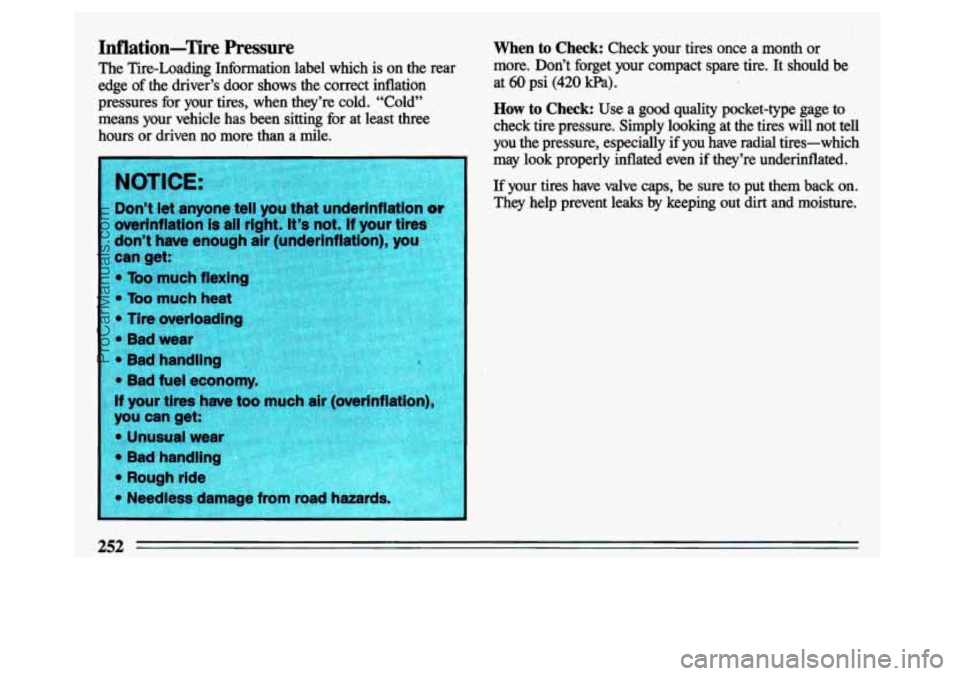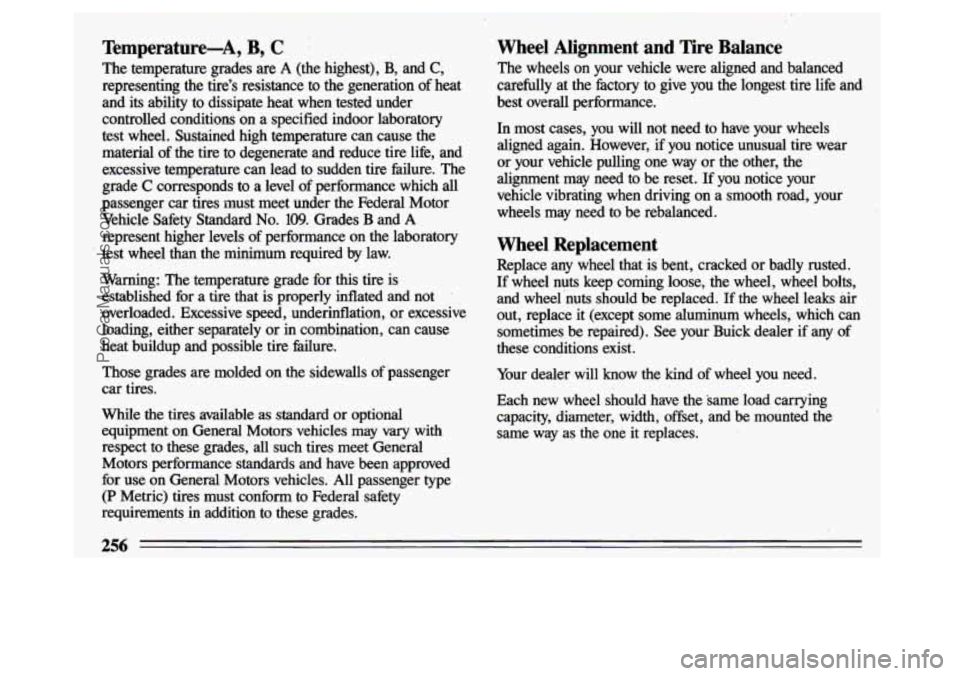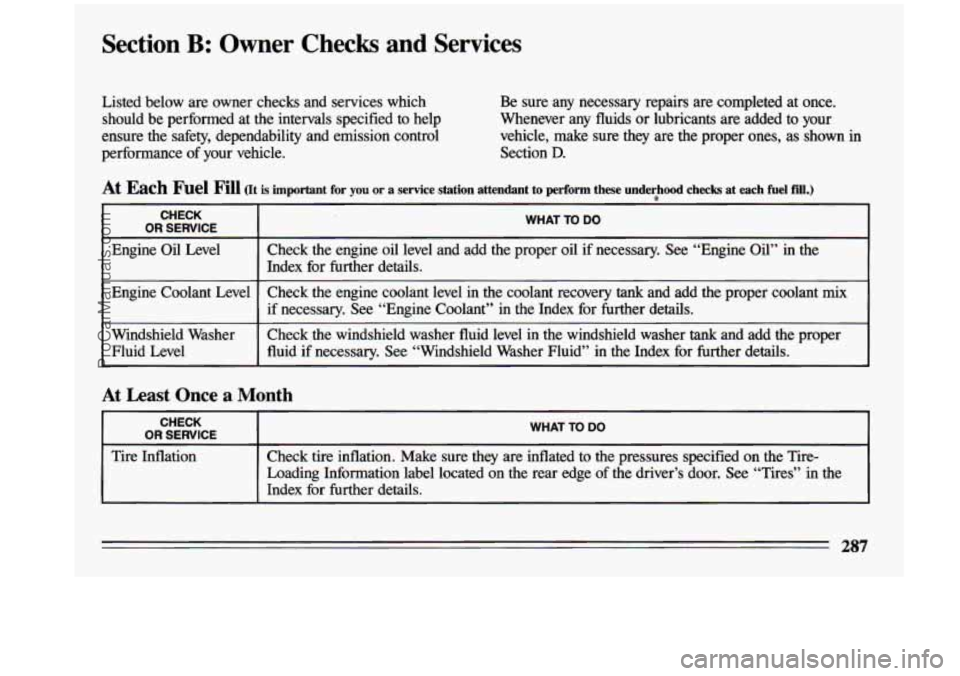1993 BUICK CENTURY flat tire
[x] Cancel search: flat tirePage 220 of 324

Compact Spare Tire
Although the compact spare was fully inflated when your
vehicle was new, it can lose air after a time.
Check the
inflation pressure regularly. It should be
60 psi
(420 Wa). The compact spare is made to go up to 3,000
miles (5 0o0 km), so you can finish your trip and have
your full-size tire repaired or replaced where you want.
Of course, it’s best to replace your spare with a full-size
tire as soon as you can. Your spare will last longer and be
in good shape in case you need
it again.
on’t take your compact spare th
utomatic car wash with guide
ompact spare can get caught damage the tire and whe
her parts
of your vehicle.
Don’t use your compact spare on some other vehicle.
And don’t
mix your compact spare or wheel with other
wheels or tires. They won’t
fit. Keep your spare and its
wheel together.
s too. Don’t us
ProCarManuals.com
Page 251 of 324

Windshield Wiper Blade Replacement
-1
Replacement blades come in different types and are
removed in different ways. Here’s how to remove the type
with a spring release:
1. Pull the windshield wiper arm away from the
2. Press down on the spring with a screwdriver and pull
3. Push the new wiper blade securely onto tL wiper
windshield.
the blade assembly off the wiper
arm.
arm.
Loading Your Vehicle
G INFORMATION
VEHICLE CAP. WT.
FRT. CTR.
RR. TOTAL LBS. KG
MAX. LOADING
& GVWR SAME AS VEHICLE
1 CAPACITY WEIGHT XXX COLD TIRE
TIRE SIZE SPEED PRESSURE
RTG PSI/KPa
Two labels on your vehicle show how much weight it
may properly carry. The Tire-Loading Information label
found on the rear edge of the driver’s door tells you the
proper size, speed rating and recommended inflation
pressures for the tires on your vehicle. It also gives you
important information about the number of people that
,
can be in your vehicle and the total weight that you can
carry. This weight is called the Vehicle Capacity Weight
and includes the weight
of all occupants, cargo, and all
nonfactory-installed options.
249
ProCarManuals.com
Page 253 of 324

n
ACAUTION:
Things you put inside your vehicle can strike
and injure people
in a sudden stop or turn, or
In a crash.
* Put things In the trunk or rear area of your
vehicle. In
a trunk, put them as far forward
as you can. Try to spread the weight evenly.
* Never stack heavier things, IPke suitcases,
inside the vehicle
so that some of them are
above the tops
of the seats.
* When you carry something inside the
vehicle, secure
it whenever you can.
* Don’t leave a seat folded down unless you
need to.
Tires
We don’t make tires. Your new vehicle comes with high
quality tires made
by a leading tire manufacturer. These
tires are warranted by the tire manufacturers and their
warranties are delivered with every new Buick. If your spare tire is a different brand than your road tires, you
will have a tire warranty folder from each
of these
manufacturers.
A CAUTION:
Poorly maintained and improperly used tires
are dangerous.
0 Overloading your tires can cause
overheating as a ngsult
of too much friction.
Mu could
have an air-out and a serious
accident.
See “Loading bur Vehicle” in the
Index.
* Underlnflated tires pose the same danger as
overloaded tires. The resulting accident
could cause serious injury. Check
all tires
frequently to maintain the recornmended
pressure. Tire pressure should
be checked
when your tires are cold.
* Overinflated tires are more likely to be cut,
punctured, or broken
by a sudden Impact,
such as when you
hit a pothole. Keep tires at
the recommended pressure.
tread
Is badly worn, or If your tlps have
been damaged, replace them.
* Worn, old tires can cause accidents. If your
251
ProCarManuals.com
Page 254 of 324

Inflation-Tire Pressure When to Check: Check your tires once a month’or
The Tire-Loading Inforlnation label which is on the rear
’ more. Don’t forget your compact spare tire. It should be
edge of the driver’s door shows
the correct inflation at 60 psi (420 kPa).
pressures for your tires, when they’re cold. “Cold”
means your vehicle has been sitting for at least
three
hours or driven no more than a ‘mile.
How to Check: Use a good quality pocket-type gage to
check tire pressure. Simply looking at the tires will not tell
you the pressure, especially if you have radial tires-which
may look properly inflated even if they’re underinflated.
If your tires have valve caps, be sure to put them back on. \
They help prevent
leaks by keeping out dirt and moisture.
252
ProCarManuals.com
Page 255 of 324

Tire Inspection and Rotation
To make your tires last longer, have them inspected and
rotated at the mileages recommended
in the Maintenance
Schedule. See “Scheduled Maintenance Services”
in the
Index.
Use this rotation pattern.
After the tires have been rotated, adjust the front and rear
inflation pressure as shown on the Tire-Loading
Information label. Make certain that -all wheel
nuts are
properly tightend. See “Wheel
Nut Torque” in the
Index.
1
I A CAUTION:
Rust or dirt on a wheel, or on the parts to
which
It Is fastened, can make the’wheel nuts
become loose after a Qlme. The wheel could
come off and cause an accident. When you
change a wheel, remove any rust or dirt from
places where the wheel attaches to the
vehlcle.
In an emergency, you can use a cloth
or a paper towel to do this; but be sure to us8
a scraper or wire brush later, if you need to, to
get
all the rust or dirt off. (See “Changing a
Flat Tlre” in the Index.)
253
ProCarManuals.com
Page 258 of 324

Temperature-A, B, C
The temperature grades are A (the highest), B, and C,
representing the tire's resistance to the generation of heat
and
its ability to dissipate heat when tested under
controlled conditions on a specified indoor laboratory
test wheel. Sustained high temperature can cause the material'of the tire to degenerate and reduce tire life, and
excessive temperature can lead to sudden tire failure. The
grade
C corresponds to a level of performance which all
passenger car tires must meet under the Federal Motor
Vehicle Safety Standard
No. 109. Grades B and A
represent higher levels of performance on the laboratory
test wheel than the minimum required by law.
Warning: The temperature grade for
this tire is
established for a tire that is properly inflated and
not
overloaded. Excessive speed, underinflation, or excessive
loading, either separately or in combination, can cause
heat buildup and possible tire failure.
Those grades are molded on the sidewalls of'passenger
car tires.
While the tires available as standard or optional
equipment on General Motors vehicIes may vary with
respect to these grades, all such tires meet General
Motors performance standards and have been approved
for use
on General Motors vehicles. All passenger type
(P Metric) tires must conform to Federal safety
requirements in addition to these grades.
Wheel Alignment and Tire Balance
The wheels on your vehicle were aligned and balanced
carefully at the, factory to give you the longest tire life and
best overall performance.
In most cases, you will not need to have your wheels
aligned again. However, if you-notice unusual tire wear
or your vehicle pulling one way or the other, the
alignment may need
to be reset. If you notice your
vehicle vibrating when driving on a
smooth road, your
wheels may need to be rebalanced.
Wheel Replacement
Replace any wheel that is bent, cracked or badly rusted.
If wheel nuts keep coming loose, the wheel, wheel bolts,
and wheel'nuts should be replaced. If the wheel leaks air
out, replace it (except some aluminum wheels, which can sometimes be repaired). See your Buick dealer
if any of
these conditions exist.
Your dealer will know the kind
of wheel you need.
Each new wheel should have the same load carrying
capacity, diameter, width, offset, and be mounted the same way as the one
it replaces.
256
ProCarManuals.com
Page 278 of 324

Introduction
A Word,About Maintenance
We at General Motors want to help you keep your vehicle
in good working condition. But we don’t know exactly
how you’ll drive it. You may drive very short distances
only a few times a week. Or you may drive long
distances all the time in very hot, dusty weather. You
may use. your vehicle
in making deliveries. Or you may
drive it to work, to do errands or in many other ways.
Because of all the different ways people use their GM
vehicles, maintenance needs vary. You may even need
more frequent checks and replacements than you will
find
in the schedules in this part. So please read this part
and note how you drive.
If you have any questions on
how to keep your vehicle in good condition, see your
Buick dealer, the place many GM owners choose to have
their maintenance work done. Your dealer can be relied
upon to use proper parts and practices.
Your Vehicle and the Environment
Proper vehicle maintenance not only helps to keep your
vehicle in good working condition, but
also helps the
environment. All recommended maintenance procedures
are important. Improper vehicle maintenance or the
removal
of important components can significantly affect
the quality
of the air we breathe. Improper fluid levels or
even the wrong tire inflation can increase the level of
emissions from your vehicle. To help protect our
environment, and to help keep your vehicle in
good
condition, please maintain your vehicle properly.
How This Part is Organized
The remainder of this part is divided into five sections:
“Section
A: Scheduled Maintenance Services” shows
what to have done and how often. Some
of these services
can
be complex, so unless you are technically qualified
and have the necessary equipment, you should let your
dealer’s service department or another qualified service
center do these
jobs.
ProCarManuals.com
Page 289 of 324

Section B: Owner Checks and Services
Listed below are owner checks and services which should be performed at the intervals specified to help
ensure the safety, dependability and emission control
performance of your vehicle. Be
sure any necessary repairs are completed at once.
Whenever any fluids or lubricants are added to your
vehicle, make sure they are the proper ones, as shown in
Section
D.
At Each Fuel Fill (It is important for you or a service station attendant to perform these undechd checks at each fuel fill.)
CHECK
I OR SERVICE I WHAT TO DO
Engine Oil Level
Check the engine oil level and add the proper oil if necessar\
y. See “Engine Oil” in the
Index for further details.
Engine Coolant Level Check the engine coolant level in the coolant recovery tank and add \
the proper coolant mix
I if necessary. See “Engine Coolant” in the Index for furth\
er details. I
Windshield Washer Check the windshield washer fluid level in th\
e windshield washer tank and add the proper
Fluid Level
I fluid if necessary. See “Windshield Washer Fluid” in the \
Index for further details. I
At Least Once a Month
CHECK
I OR SERVICE I WHAT TO DO
Tire Inflation Check tire inflation. Make sure they are inflate\
d to the pressures specified on the Tire-
Loading Information label located on the rear edge of the driv\
er’s door. See “Tires”
in the
Index
for further details.
287
ProCarManuals.com